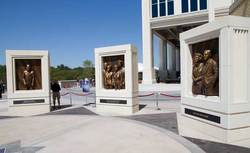
Just outside the stadium's west side is Founders' Plaza, featuring bronze plaques of the principal donors, as well as tributes to University pioneers Addison and Randolph Clark.
By Rick Waters
The TCU Magazine
"The Carter" is ready for its close up.
TCU cut the ribbon and officially dedicated Amon G. Carter Stadium last Thursday after 21 months and $164 million of renovation, including the implosion of its west side and iconic upper deck in December 2010 and demolition of its east side a year later.
All that is past now, as University administrators and TCU Athletics honored the donors, trustees and members of the stadium renovation committee, as well as architect HKS and builder Austin Construction at a pep rally-like ceremony beside the new Founders Plaza on the west side. An estimated 2,500 season ticket holders, alums and fans also watched the proceedings before exploring the structure on self-guided tours."It's an amazing day in TCU history," said Chancellor Victor J. Boschini, Jr. "This is really a celebration — a huge 'thank you' — to all the people who made this stadium possible. It's the largest and probably most visible building on our campus and it's a major landmark for Fort Worth. So this is a big day for the city, too."
Mayor Betsy Price and Fort Worth City Council members Joel Burns and Jungas Jordan joined the festivities and helped cut the ribbon.
"It's amazing!" Price said after the ceremony. "It is such an impressive facility and will be a proud home for the TCU community for years to come. I think it will be the envy of all the Big 12 fans that come through here."
The $164 million renovation essentially created a whole new stadium. Everything but 20 rows of bleachers closest to the field was razed and reconstructed — a four-level west side with 25 suites, 2,400 club seats, 23,000-square-foot club, a two-tier press box, enlarged visiting team locker room, as well as gameday operation spaces. Just outside the west side is Founders' Plaza, featuring bronze plaques of four of the principal donors, as well as tributes to university pioneers Addison and Randolph Clark. Inside, six founding donors will enjoy their own Founders' Club and suites.
The 5,000-seat north end and two-tiered east side are new as well, with wider concourses and additional concession areas. An enlarged North Deck surrounds the base of the 56-foot-by-30-foot videoboard and will accompany additional standing-room-only ticket holders. The north outside facade features two of the 1930s art deco stone plaques from the old stadium. On the east side, a redesigned Frog Alley with landscaping and legacy bricks provide an attractive new entrance facing the campus. By mid-October, an 8-foot bronze horned lizard statue will provide a new campus landmark, and in November, the planned Circle of Excellence will be completed.
In all, the project used 791,520 TCU buff-colored bricks and more than 66,000 tons of concrete, said Ross Bailey (Athletics). HKS, which also designed Cowboys Stadium in Arlington, worked to bring out the southwestern art deco style from the original stadium construction in 1929 and 1930. "We went back to the original schematics for the original Amon G. Carter Stadium and found some elements they wanted to include but couldn't because of cost. We wanted to put those into the renovation as a kind of homage to the TCU of old," Bailey said.
But it has plenty of new. Bailey counts 268 televisions, three natural-gas fireplaces and 360-degree views of the field in the concourse.
Coach Gary Patterson notes that the project has been a life-changing moment for those involved. "It wasn't just about building a stadium to play football games in," Patterson said. "It's been about changing a community and giving students and the alumni something to be proud of for a long, long time.View the videos and photo gallery at
http://www.magazine.tcu.edu/OnCampus/Article.aspx?ArticleId=387
